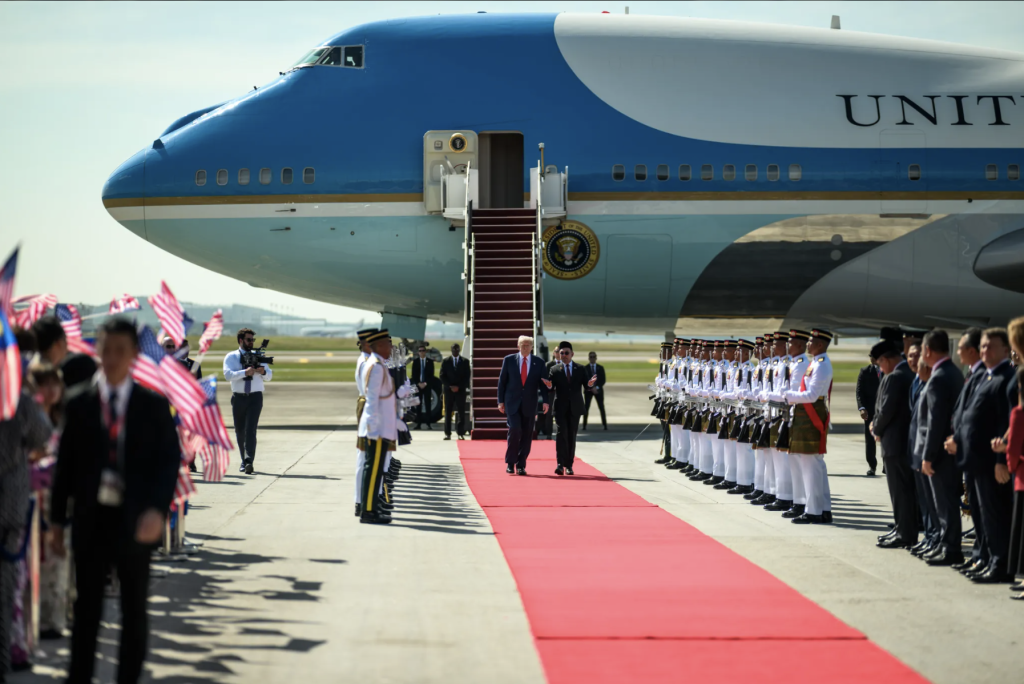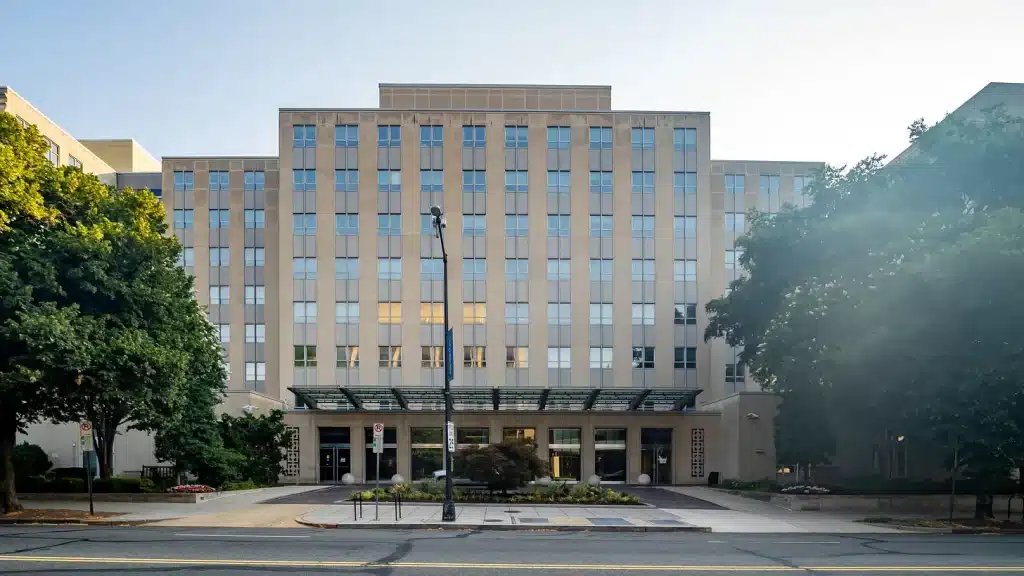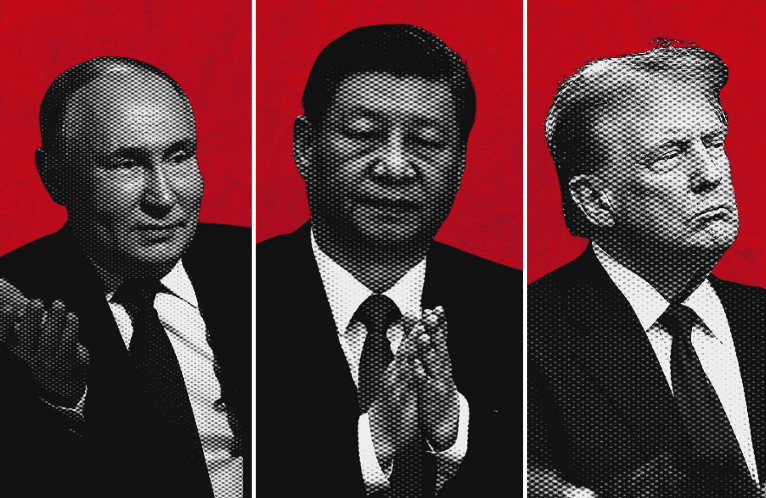President Obama’s Asia Scorecard
President Barack Obama inherited a sensible Asia policy from President George W. Bush seven years ago. In the years since, his administration’s policies have further strengthened America’s position in the region.
This is the first time that any presidential administration has explicitly identified Asia as the top priority of U.S. foreign policy. “I have made a deliberate and strategic decision,” Obama told the Australian parliament in a speech on November 17, 2011. “As a Pacific nation, the United States will play a larger and long-term role in shaping the region and its future.” Obama’s “pivot” to Asia — also termed the “rebalance” — has been successful on the whole, despite being underresourced and compromised by Washington’s budget battles and ongoing preoccupations in the broader Middle East.
As a result of the pivot policy, the United States is even more deeply engaged and respected throughout the region. Most Asian states are comfortable with their deepened ties with Washington. Indeed, since 2009, they have sought it, having increasingly felt the rising presence of China. The Obama pivot came in large part as a response to the growing angst about China throughout the region, as well as from the realistic recognition that the broad Indo-Asian region is the most important geoeconomic and geostrategic region in the world and for America’s broad national interests.
A year from now, at the inauguration of the 45th president of the United States, Obama’s successor will inherit a generally sound situation — barring, of course, any unforeseen events and a few potential flashpoints. Yet the next president also will confront the principal challenge of not overplaying America’s currently strong hand.
Prioritizing Asia
Part of this prioritization is a matter of physically showing up — something American officials have long been criticized for not doing. To date, President Obama has made nine visits to East Asia, visiting every country in the region except Brunei, Laos, Mongolia, New Zealand, and Vietnam, and he will visit Laos and Vietnam later in 2016. Hillary Clinton was a constant presence in Asia during her term as secretary of state, although John Kerry has spent far less time in the region. Secretary of Defense Ash Carter has made Asia one of his highest priorities, and during his short tenure in office he has visited the region several times.
The U.S. military has also upped its presence and deepened its partnerships and alliances across Indo-Asia. Countries that previously had no or minimal security ties with America — nations such as Indonesia, Malaysia, Myanmar, and Vietnam — have seen their defense relations with the United States established or significantly expanded. In 2013, formal defense cooperation with New Zealand resumed after a three-decade hiatus, thus reactivating their allied relationship. Even though the Philippines have been a longtime ally, actual defense collaboration had waned badly until the two countries agreed to the Enhanced Defense Cooperation Agreement in 2014. Singapore has increased its already strong defense cooperation and role in hosting the U.S. Navy at Changi Naval Base (including four new littoral combat ships) — a relationship that the U.S. government describes as a “maintenance and resupply hub for U.S. military assets.” In India, the expansion of military ties has improved relations to what both sides describe as “an all-time high,” anchored by the 2015 Ten-Year Defense Framework Agreement and the U.S.-India Joint Strategic Vision for the Asia-Pacific and Indian Ocean. The American and Indian navies now regularly exercise together in the Indian Ocean, and India has begun to purchase arms from the United States.
Meanwhile, the traditional alliances with Australia, Japan, and South Korea also have been significantly expanded and deepened. In addition to the 49,000 American forces stationed in Japan and 28,500 in South Korea, the Obama administration has added 1,500 Marines in Darwin, Australia. The alliance with Thailand, however, has been strained since the 2014 military coup; as a result, Bangkok has drifted into Beijing’s ready embrace.
In enhancing these security alliances and partnerships, the Obama administration seeks to develop and improve regional security structures. As the president flew to Asia in November 2015, the White House released a lengthy statement on his Asia policy. “We are moving beyond the ‘hub and spokes’ model of the past,” it read in part, “toward a more networked architecture of cooperation among our allies and partners — including through expanded trilateral cooperation frameworks — built on shared values and interests.” This framework is a basic departure from Washington’s six-decade approach anchored solely on bilateral alliances. It should provide the United States with greater flexibility and overall influence through more diversified defense relationships throughout the region.
Beyond security ties, of particular significance has been the strengthening of American diplomatic and economic ties with the 10 member states of the Association of Southeast Asian Nations (ASEAN), individually and collectively. Southeast Asia has always been the neglected stepchild in U.S. regional diplomacy, long crying out for attention but never getting it. President Obama and his administration have reversed this longstanding neglect, with the change in attitude symbolized by hosting all 10 heads of state at the third U.S.–ASEAN summit in Sunnylands, California, on February 15, 2016.
With 632 million people and a collective $2.4 trillion in gross domestic product (GDP) — $6.64 trillion in purchasing power parity terms — the ASEAN 10 constitute the world’s seventh-largest economy. As their economies have rapidly developed, so too have opportunities for U.S. trade and investment. In 2014, ASEAN was America’s fourth-largest trading partner, trading $254 billion in goods and services, while the total stock of American direct investment in the region grew to $226 billion — greater than China, Japan, and the European Union combined. U.S. companies poured $32.3 billion into the region between 2012 and 2014 alone.
The intensified American relationship with Southeast Asia is embodied in the recently agreed ASEAN-US Plan of Action 2016–2020. In addition to bolstering wide-ranging exchanges in the cultural and commercial spheres, the action plan commits the United States to deeper multilateral diplomatic and security engagement though ASEAN-sponsored dialogues: the ASEAN Regional Forum, the ASEAN Defense Ministers Plus, the ASEAN Post-Ministerial Summit, the ASEAN-U.S. Leaders Meeting, the East Asian Summit (EAS), and several other multilateral mechanisms. Since its inception in 2005, the EAS has gained importance steadily, joining the Asia-Pacific Economic Cooperation forum as the premier regional conclaves where all of Asia’s leaders convene annually. Also, early in its tenure, the Obama administration also took the important step of acceding to ASEAN’s Treaty of Amity and Cooperation, and in 2010 the State Department appointed its first ambassador to ASEAN. All in all, America’s relations with the vitally important Southeast Asian countries have never been better.
In Northeast Asia, the Obama administration has also worked to solidify already strong ties with states. In April 2015, Japan’s charismatic Prime Minister Shinzo Abe paid one of the highest-profile state visits ever by a Japanese leader to the White House — reciprocating Obama’s equally symbolic state visit to Japan one year earlier. U.S.-Japan ties have never been stronger.
Ties with ally South Korea appear strong on the surface, but underneath Seoul seems to be tilting toward Beijing, to the concern of American officials. Countering North Korea’s aggressiveness and nuclear weapons program produces common cause, while the 1953 Mutual Defense Treaty anchors the bilateral relationship. Nonetheless, President Park Geun-hye’s flirtation with Beijing has aggravated some in Washington, although more recently the United States and South Korea are equally exasperated with China’s failure to pressure Pyongyang following its fourth test of a nuclear bomb (this time, allegedly, a hydrogen device) and ballistic missile, respectively, in January and February 2016. President Park had been gambling that her cozy relationship with Beijing would result in it successfully deterring Pyongyang’s military ambitions, and she may now be realizing that her accommodation of China has failed to achieve her aims. It has similarly failed Washington’s aims. The Obama administration’s North Korea calculus has been one of “strategic patience” toward Pyongyang while counting on Beijing to bring the North Koreans to heel. This strategy was flawed from the outset, as China values North Korea’s sustainability more than anything else. The next president will have to carefully consider other, more coercive options toward Pyongyang, and not rely on China to solve the problem.
Elsewhere in Northeast Asia, American ties with Taiwan also remain sound, as Washington has welcomed the dramatic expansion and stabilization of the island’s ties with the mainland under outgoing president Ma Ying-cheou. Taipei’s newly-elected president, Tsai Ing-wen, takes office in May 2016, and she has sought reassure both Beijing and Washington that she will seek to uphold the status quo. In December 2015, the Obama administration also announced a $1.83 billion arms package to strengthen Taiwan’s defenses and backbone in the face of possibly increased coercion from China. Nearby, in Hong Kong, Washington has stood by and watched a dramatic political drama unfold between prodemocracy citizen and student activists and a Beijing-controlled local administration. There is now a pervasive sense in the former British colony that the “one country, two systems” deal struck in 1997 (and written to last for 50 years) is being eroded on a daily basis through Beijing’s creeping control over local politicians, media, the publishing industry, the financial sector, nongovernmental organizations, and academia. Washington’s and London’s silence in the face of this encroachment is inexcusable.
The Obama administration has not paid as much attention to Central Asia, much like the Bush administration before it. Given the much higher equities elsewhere in Asia, though, this position probably makes sense. Moreover, the region is a strategic space contested primarily by Russia and China, filled with repressive autocracies and terrorist networks.
In South Asia, the United States has also further solidified ties with India, continuing a trend dating back to the Clinton and Bush administrations. Prime Minister Narendra Modi and Obama have exchanged highly publicized state visits. Symbolically, Obama was the first American president ever invited to attend India’s National Day celebrations. For his part, Modi has become an icon within the Indian-American community, and India’s growing upper-income households are sending students to American schools. The Institute of International Education reports that 132,888 Indian students were attending U.S. universities in 2014–15, making India the second-largest source of foreign students in the United States, behind only China’s 304,040. Commerce between the United States and India is similarly flowing, with trade topping $100 billion and two-way investment reaching $35.8 billion in 2014. As noted above, the two militaries work together more closely than ever, while the two governments have proclaimed a “global partnership.” India has clearly become one of America’s favored Asian nations.
Feeling Reassured, but Anxious
As a result of America’s strengthened support and deepened regional engagement, Asian states now feel increasingly secure in light of China’s increasing regional role. This was not the case just a few years ago. They all live next to (and in) China’s shadow.
Obama’s successor will need to further deepen U.S. ties throughout the broad Indo-Asian region — extending from Afghanistan to the South Pacific — in order to reassure these states without pressuring them into an anti-China coalition. If China is overbearing, the regional balance of power will naturally tilt against it. Similarly, if the United States is overbearing, some nations may tilt toward China. It presents a delicate balancing act for Washington.
It must be said that the one regional relationship that has deteriorated on Obama’s watch is that with China. This deterioration is not because of the Obama administration’s policies — which have been quite prudent overall — but owes more to both countries’ increasingly divergent interests and deep strategic mistrust. From the U.S. perspective, it is also due to China’s internal repression, increased pressure on American companies and corporate cyberespionage, steady military modernization, diplomatic assertiveness and economic diplomacy, and island-building in the South China Sea. (Obama has ordered the U.S. Navy to conduct freedom-of-navigation patrols inside China’s claimed island zones.) From Beijing’s perspective, the United States is trying to strategically encircle it externally while undermining its regime internally. Presidential summit diplomacy has been able to arrest this dynamic of suspicion temporarily, but the overall trajectory of Sino-American relations has been steadily downward since President Bush left office in 2009.
As a result, the major overarching dynamic in the broad Indo-Pacific expanse today is the growing strategic competition between the United States and China. All nations in the region are, in one way or another, impacted by this dynamic. But they each react in different ways. They do not want the Sino-American regional competition in East Asia to intensify or spread to South and Southwest Asia: they know well the old Indian proverb, “When the elephants fight, the grass is trampled.”
Most Asian nations wish to maintain sound economic ties with both the United States and China, while relying on the United States to provide mutual and regional security. Although China is the number-one trading partner for most Asian countries, commercial ties with the United States are also significant. American trade in goods with Asia is more than twice as much as with Europe, totaling $1.62 trillion in 2014. American direct investment in the region is the largest of all nations. Thus, it is not entirely correct to distinguish, as some do, between an “economic Asia” dominated by China and a “security Asia” dominated by the United States. In Asia, the United States is just as economically important as is China.
This importance will deepen significantly as the Trans-Pacific Partnership (TPP) — President Obama’s signature regional initiative — takes shape. After seven years of intensive negotiations, the 12 TPP founding members came to agreement on a common draft in October 2015. The mammoth agreement, covering 30 separate issue areas, now awaits formal signing and ratification by all member states. Yet its passage by the U.S. Senate remains in doubt; if it fails to pass, it would be a diplomatic (and economic) disaster for the United States. TPP brings together some odd economic bedfellows: the United States, Brunei, Australia, Japan, Canada, Chile, Malaysia, Mexico, New Zealand, Peru, Singapore, and Vietnam. Collectively, these economies account for 40 percent of global GDP ($27.5 trillion). Obama has been blunt in his rationale for the agreement: “If we don’t write the rules, China will write the rules in that region.” China has not been party to the negotiations, and its domestic economy and trade and investment practices remain a very long way from complying with the high standards set by TPP. Other nations, such as South Korea, are more qualified and are eager to join in the second round of admissions.
Knotty Problems
Although President Obama’s administration deserves high marks for its Asia policy, it will bequeath to its successor some potential flashpoints. The region has known interstate peace since the 1980s, but several potentially volatile locales could erupt into armed conflict: North Korea, China-Japan (over the Senkaku/Diaoyu islands), China-Taiwan, China-Vietnam, and China-Philippines (over the South China Sea). The potential for each latent concern to spin into open conflict is not insignificant, and the United States easily could be drawn into these kinetic scenarios.
Central to all of these lurking crises is China’s uncertain regional role and its reaction to U.S. moves. Beijing is not at all comfortable with the strengthened American position around its periphery. Unsurprisingly, China is engaged in its own efforts to strengthen political relationships, deepen economic dependencies, broaden its military footprint, probe American alliances and security partnerships, and construct alternative multilateral institutions such as the new Asian Infrastructure Investment Bank. Beijing has also unveiled its ambitious “One Belt, One Road” initiative — massive twin projects to build infrastructure and ultimately tie China to Europe across the Eurasian landmass, and across the vast Indian Ocean and up the Red Sea to the Mediterranean. Beijing has already committed $233 billion in potential funding for this initiative. Time will tell if the initiative materializes, but there is no doubt that China is engaged in a multifaceted economic offensive across Asia.
As a result, the United States and China are increasingly in competition. This is neither unexpected nor unnatural; it is the “new normal.” The next American administration will inherit this major power dynamic. The question is whether such strategic competition can be peacefully managed. This is not a zero-sum game, although it could devolve into one if it is mismanaged by both sides. The stakes are high, and mutual mistrust runs deep. The relationship does have the potential to hemorrhage and deteriorate into a fuller adversarial posture if it is not managed intelligently. At the same time that this competitive dynamic plays out on the regional stage, Washington also needs to work together effectively with Beijing in the global arena. Even within Asia, both powers seek regional stability — the problem is that both see the other as contributing to instability and undermining each side’s national interests.
Thus, of all the complex and critical foreign policy challenges that will confront the next president of the United States, the most vital issue will be to constructively manage relations with the world’s other major power: China. This will be no easy task, and will require astute-but-tough statesmanship. Above all, the best way to manage relations with China is through a broad and strong set of American relations throughout the Indo-Asian region, all around China. It is a strategy that several successive presidential administrations have understood and pursued, and President Obama’s successor can begin by continuing this strategy and legacy.
By DAVID SHAMBAUGH Winter 2016 on The Wilson Quarterly
Read more here








